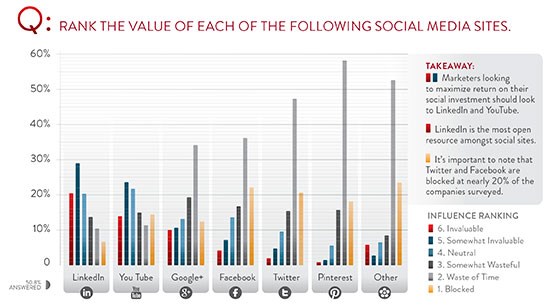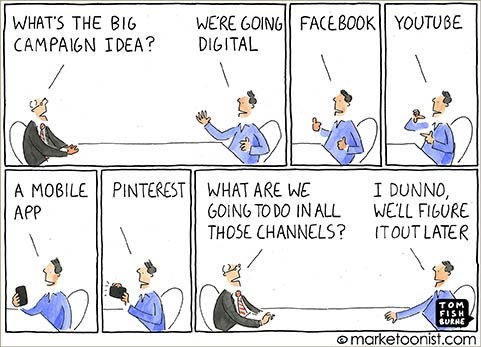Gardner’s Media Usage in Manufacturing 2014 – Part 6: Social Media; a Dichotomy of Perceptions
Insights: Social Media: Buyer and Seller May Be On Different Pages It’s said knowledge is power . . . never truer than in the “Information Age.” The final post in a series discussing Gardner Business Media’s research study, Media Usage in Manufacturing 2014 and what it might mean to the B2B marketer.
Social Media Begins to Affect the Buying Process
But There’s Dichotomy in How Buyers and Sellers View Social
By Mark Semmelmayer
Chief Idea Officer
Pen & Inc. Marketing Communications

This is the final part series, discussing Gardner Business Media’s research study, Media Usage in Manufacturing 2014. The series breaks down study findings, and their implications for the B2B marketer. Download the report here.
In this post, we’ll explore the developing, somewhat murky, change in social media utilization by both B2B buyers and sellers.
The Joe Friday version (for those too young to remember TV’s “Dragnet,” his signature line was “just the facts, ma’am. . .”), Gardner’s survey shows 56% of business buyers don’t use, or rely on, social media in purchase evaluations. For the 4th consecutive year, however, the survey reveals an increased use of social media. But, “Despite increased adoption, the perception of social’s usefulness continues to fall below average as a business tool and information resource.”
If you look at social channels buyers use, less than 20% of the respondents found the leading social outlets, LinkedIn or YouTube, indispensable in the search process. At the same time, 40% to more than 60% found other channels to be a “waste of time,” including Facebook, Google+, Twitter and Pinterest. Special note to Twitter believers: the “useless” factor was nearly 50% for that channel.

Seller: “I want . . . something”
Old-school marketers want to go for the jugular, even when it comes to social media. In a 2012 survey, Eloqua investigated how B2B marketers in the UK use social media to promote, engage and sell.
Only 64% of the companies surveyed used social media as a marketing tool, meaning that more than a third did not.
Companies cited three reasons for using social media: creating brand awareness (83%), encouraging social sharing (56%) and gaining trust and followers (55%). 32% said they use it for lead generation, while only 16% use social media to assess market perception of their brand.
PR/communications departments were most often responsible for the social media strategy at 26%. The next most common arrangement for social media is sharing across different departments at 23%. Only 11% of companies leave social media management to the web team.
43% admit they have no strategy in place for incorporating social media into demand generation. A third were unclear of the value and 18% said a lack of tools prevented them from using social media for lead generation.
With a variety of new social media applications and tools appearing continually, marketers were asked which they find most ‘intriguing.’ Social sharing buttons raised the most interest (29%), followed by social activity widgets (22%) and social sign-on (10%).
. . . and the B2B buyer may want something else.
According to a 2012 Demand Gen Report B2B Buyer Survey, social media plays an increasing role in the B2B buying process today. Some relevant findings:
- Blogs and LinkedIn content are the most influential sources during the vendor selection process. SlideShare and YouTube were also as influential
- As in the Gardner Survey, Twitter, Facebook and Pinterest scored low in influence
- 53% of buyers follow group discussion related to their vendor research
- 22% pose questions on social media sites as part of their research
- 24% connect directly with potential solution providers over social media
Social sign-in, touted as a simpler way to manage the information-gathering process, has very little traction in the B2B space: Just 5% of buyers said the sites they visited use social sign-in tools. Three quarters say they aren't interested in using social sign-in.

Practical Implications: Your Social Strategy Needs Work . . . If You Have A Strategy At All!
Let’s be clear. There’s nothing clear about the value of social media in B2B . . . today. What’s clear is that it has a place, albeit ill defined, that’s growing. That means you need to be in the social space, now. The question is, how?
Some thoughts:
- Draft a social media strategy designed to work with your Integrated Marketing Communications (IMC) program.
- Keep the strategy relatively simple, at least for now. Focus on what the buyer uses today: blogs, LinkedIn and YouTube. Don’t ignore the other channels, but don’t invest major resources until you can prove their worth.
- Listen to the buyer: they want blogs and content truly relevant to their purchase research. Don’t overlook these channels as brand builders.
- IMHO (social shorthand . . . In My Humble Opinion), creating and executing the strategy should be assigned to your web team. They are already steeped in the kind of data and analytics required to evaluate the impact of social efforts.
- Make sure the web team has a seat at the marketing/communications IMC planning table. Task them to continually monitor social results and use those analytics to adjust social strategy on the fly and craft continually improving integrated communications plans.
Need more information?
Mark Semmelmayer
Chief Idea Officer
Pen & Inc. Marketing Communications
2015 G.D. Crain Jr. Award Winner
Inductee, Business Marketing Hall of Fame
LinkedIn


